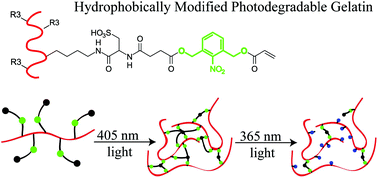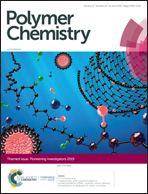Mechanically robust photodegradable gelatin hydrogels for 3D cell culture and in situ mechanical modification†
Abstract
Recent developments in photodegradable (PD) hydrogels have allowed researchers to study cell behavior in response to spatial and temporal changes to the extracellular environment. To date, most PD hydrogel systems have been composed of poly (ethylene glycol) (PEG) based macromers that crosslink via end-linking gelation. PEG-based hydrogels, however, are not optimal for three-dimension cell culture, as they neither allow for cellular proliferation nor restructuring of the matrix. Unlike PEG-based hydrogels, gelatin, a naturally derived material, contains enzymatically degradable sites and cell binding domains, making it an attractive biomaterial for three-dimensional cell culture. To this end, researchers have modified gelatin to contain methacrylamide groups (GelMA). This allows the gels to be chemically crosslinked, rendering them stable at physiological temperatures. A few groups have also reported the synthesis of PD gelatin, but the incorporation of photodegradable groups is hampered by poor conjugation efficiency and poor solubility, leading to insufficient mechanical properties. In this work, we develop a PD gelatin hydrogel system that is mechanically robust and can be easily produced in large quantities. Specifically, we chemically modify the gelatin with highly hydrophilic groups which, in turn, adjust the isoelectric point and charge density of the protein. This modification results in a highly soluble PD-gelatin that can be crosslinked into a gel and subsequently degraded with exposure to light. These PD-gelatin gels exhibit mechanical properties similar to GelMA gels, but with the extra ability to be spatially and temporally patterned with light. Photodegradation of the gels can be done either before cell seeding or in the presence of cells. We show that cells respond to both patterned structures and in situ softening of the network in 2D, while in situ softening in 3D does not affect morphology at the compositions and time scales investigated.

- This article is part of the themed collection: Pioneering Investigators


 Please wait while we load your content...
Please wait while we load your content...